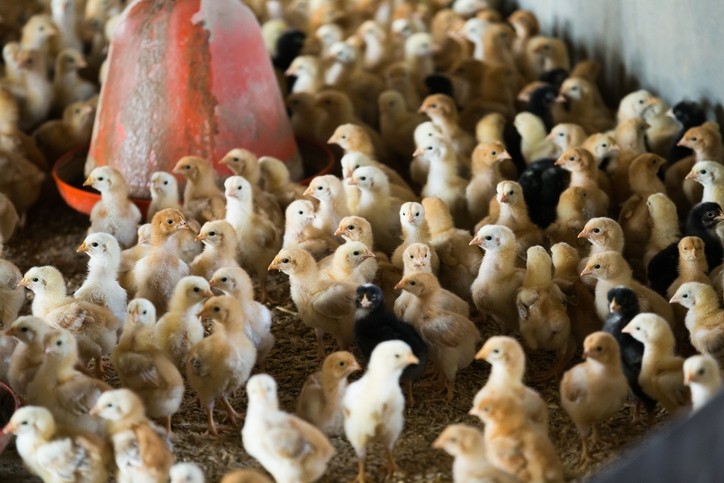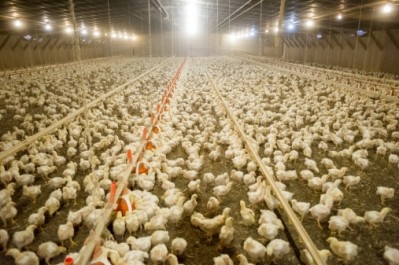Betaine additives may boost gut health for young birds

An international team of researchers from Brazil and the UK explored the influence of dietary fiber and betaine on the gut health of broiler chickens. Group members published details of their research in the journal, Livestock Science.
“The objective of this trial was to evaluate the effect of dietary fiber and betaine supplementation on osmolality, sialic acid secretion and goblet cells number in duodenum of broiler chicks between hatch and 14 days of age,” the researchers said.
Osmolaity overview
“Osmolality reflects the concentration of soluble organic and inorganic components with low molecular weight,” the researchers said. “Plasma osmolality is maintained at a constant level mainly through regulation of the concentration of minerals such as sodium, potassium, chloride and soluble proteins.”
Digesta osmolality is considered a key indicator of the “quantity of soluble nutrients present in the digesta,” they added.
The researchers found sialic acid secretion fell as birds aged and goblet cell count at day 14 and adding 5 kg/ton of betaine reduced sialic acid production for birds on the low fiber diet.
Birds on either the high fiber or 5kg/ton betaine feeds saw lowered goblet cell count and adding 1 kg/ton of betaine dropped the osmolality of digesta regardless of bird age.
“Osmolality in plasma and digesta was maximized at 4 days of age in broiler chicks,” they said. “Sialic acid secretion and goblet cell count were increased at the same age, suggesting that these parameters are a response to increased osmotic pressure.”
“Betaine inclusion reduced digesta osmolality, the number of goblet cells and, in the low fiber diet digesta sialic acid content,” they added. “Results suggest that the inclusion of an osmoprotectant such as betaine counteract the effect of high digesta osmolality on epithelial cells and consequently reduce the protectant stimulus for goblet cell differentiation and mucus production.”
Focus on intestinal integrity
When birds hatch, the gut has not finished developing and cannot digest or absorb nutrients efficiently, the researchers said.
The production of endogenous enzymes, membrane transporters along with cell differentiation and villus and crypt formation finish developing when birds reach 7 or 10 days of age.
“Intestinal integrity is determined by factors such as villus structure, microbiota profile, and the expression of genes related to specific proteins involved in tight junctions, mucus production and interleukines,” they added.
As a bird’s digestive system is maturing, digestion and nutrient absorption can be insufficient for the first few days following hatch, especially for energy and protein, they said.
As bird growth rate has increased, the starter phase has become a larger portion of a bird’s total lifespan.
Having non-absorbed or indigestible nutrients in the intestine creates osmotic pressure and moves water to the lumen, the researchers said. The nutrients also may provide a substrate for microbial growth.
"Taken together, the current results and those of Klasing et al. (2002) suggest a role for dietary betaine in managing the changes in the intestinal environment and the concomitant modulation of mucus production."
Non-starch polysaccharides (NSP) can be found in the cell walls of broiler feed ingredients, they said. However, NSP is not used by the bird and may create an impediment to digestion or the uptake of other nutrients.
“Inclusion of significant quantities of fibrous ingredients have also been related to reduced nutrient digestibility and performance,” the researchers said. “Fibrous ingredients have been reported to promote gizzard growth and modulate the intestinal microbiota in broiler chicks in the early stages of growth, thereby supporting improved performance later in life.”
Dietary fiber characteristics also could change responses to its inclusion in the diet, they said.
In previous research with rats, villus growth and enteroglucagon secretion were linked to the inclusion of fermentable fiber in diets, however, that connection was not found with non-fermentable fibers.
Why use additive betaine?
Betaine is generated from sugar beets and has osmoprotectant characteristics, the researchers said. It can be used in broiler production to replace other methyl donor ingredients like methionine or choline.
“In the event of increased osmotic pressure, Kettunen et al. (2001a) showed that movement of water out of intestinal cells was reduced in chickens fed betaine,” they said. “Transport of betaine into cells is coupled to the diffusion of Na+ and Cl− across the cell wall (Burg, 1995) and thus when osmolarity of the luminal fluid increases, betaine uptake is enhanced resulting in the accumulation of betaine within the epithelial cell.”
The additive also is considered to have a protective influence on the intestine as it improves epithelial cell morphology and can stabilize the structure of gut mucosa, they said. Its use has been linked to improved nutrient absorption in poultry.
“Therefore, the positive effects of betaine on intestinal integrity and health could benefit younger birds during gut development,” the researchers said.
Feeding trials overview
In the feeding trial, 250 male broiler chicks were given one of eight diets for a 14-day period, the researchers said. The diets included a low or high fiber about and betaine at 0, 1, 3, or 5kg per ton.
Feed ingredients were analyzed before diets were generated, they said. A commercially available betaine additive was used to make the trial feeds.
A selection of chicks was harvested upon hatching to collect blood and duodenum samples, they said. Additional birds from each diet group were collected on days 4, 9 and 14 for blood, duodenum and digesta sampling and analysis.
Collected samples were checked for sialic acid secretion and goblet cell count along with plasma and digesta osmolality, the researchers said.
Results established
After reviewing feed ingredients, fiber concentration was determined to be higher than expected for both sets of diets, the researchers said. Crude protein, ether extract, calcium, phosphorus, moisture and betaine levels were similar to expectations.
Plasma osmolality was increased at day 4 compared to birds at hatching or at day 14, they said. Digesta osmolality also increased at day 4 compared with results for day 9 or 14.
Adding 1 kg/ton of betaine lower the digesta osmolality compared to results for birds getting a non-supplemented diet, or one with 5 kg/ton betaine, they said. However, the feed additive did not alter plasma osmolality.
The amount of dietary fiber did not alter the osmolality for either plasma or digesta, they added.
“The number of Goblet cell count counted in villi was influenced by bird age, betaine inclusion and diet type, with fewer cells at 14 d compared to 4 and 9 d,” the researchers said. Adding 5 kg/ton of the feed additive reduced the number of goblet cells compared to birds that received a non-supplemented diet, and the presence of more dietary fiber reduced the number of goblet cells in the villus.
Mucus generated by goblet cells provides a protective barrier against both pathogenic and environmental challenges, they said. Its production can be checked by sialic acid concentration as a high level of sialic acid is linked to cell death, bacteria and pathological conditions along with osmotic fragility.
Sialic acid production fell as birds aged, they said. However, there also was a reaction between dietary fiber level and betaine inclusion.
“Inclusion of 5 kg/ton of betaine reduced sialic acid secretion when broiler chicks were fed the low fiber (corn/soybean meal) diet but a similar effect was not observed when the high fiber (corn/soybean meal/rice bran) diet was fed,” they said. “Sialic acid secretion correlated positively with goblet cell count, plasma and blood osmolality.”
“Correlations between sialic acid secretion, plasma and digesta osmolality, and goblet cell number supports such a hypothesis, whereby an increase in osmolality results in an increase number of goblet cells which secrete more mucus as a protective response to the osmotic challenge,” the researchers said. “Goblet cells specialize in mucus production and their number and rate of differentiation in the villus and the amount of mucus they produce (as determined by digesta sialic acid content) is stimulated by high digesta osmolality.”
Goblet cells also fell as the amount of the betaine additive increased, they said. “These results suggest a role for dietary betaine in reducing endogenous nutrient losses and inflammatory responses during the stressful time following hatch,” they added.
Source: Livestock Science
DOI: doi.org/10.1016/j.livsci.2018.12.005
Title: Influence of dietary fibre and betaine on mucus production and digesta and plasma osmolality of broiler chicks from hatch to 14 days of age
Authors: T. dos Santos, S. Baal, S. Lee, F. e Silva, M. Scheraiber, A. da Silva















